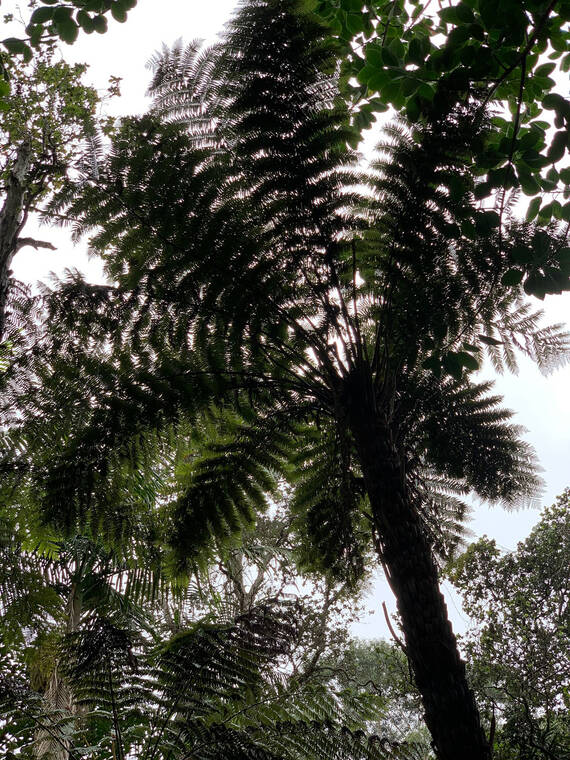Ferns have been around for over 360 million years. Giant tree fern forests were common for millions of years but they gave way as flowering plants evolved to take their place. Today most of the nearly 800 species of tree ferns are considered endangered because of climate change. Even in Hawaii we see a fraction of the tree fern forests that existed before the 19th century. The introduction of pigs by early Polynesians and later the introduction of cattle played an important part of forest destruction.
Ferns are a good example of a whole family of plants that are very poorly represented in our gardens. It’s not that they can’t be grown, but that we don’t give them much of a try. Ferns, in general, are free of insect and disease problems. They require very little fertilizer but do require moisture and shade from intense sunlight. Our cooler mauka areas and east side of the island are probably the best for growing ferns, but many types may be grown almost anywhere with protection.
We have hundreds of ferns native and introduced to Hawaii, but this is just a fraction of the more than 9,000 species found throughout the world. Members of the fern family vary from moss like mini ferns to gigantic palm like tree ferns over 50 feet in height. There are many ferns that live attached to trunks and branches of trees like the native Bird Nest Fern, Asplenium nidus, and the Austral Asian Staghorn ferns, Platycerium species. Most ferns prefer those shady, moist locations but some species will take full sun, so there is a spot in your garden for at least one or two types.
A side benefit of ferns is that some are edible. Some examples are the swamp Fern and “warabi.” The swamp Fern, Ceratopreris thalictroides, found growing wild in moist areas may be eaten either raw or cooked as greens. Our native tree fern or hapu‘u, has an acrid substance so strong that the newly emerging leaf must be boiled outside for 30 to 45 minutes since they contain irritating fumes. After boiling, the outer skin is peeled off and the interior portions are soaked in fresh water. The water is discarded and replaced with fresh water each day. This procedure takes 3 to 4 days. Then they may be stored in the water and refrigerated for several months. Fern shoots add an exotic touch to vegetable and pork dishes along with bamboo shoots.
In Hawaii our native Cibotiums are being used in the landscape but are slow growing and are becoming scarce. The hapu‘u ii or male fern usually dies after transplanting unless under ideal conditions. The so called female fern may be transplanted before new leaves emerge in the spring, but often die when planted out of their natural wet habitat. To establish them, plant in a rich organic soil and keep them moist and shaded. Within a couple of weeks, they will begin developing large airy leaves and roots. A shady spot protected from wind is best. They should be watered on the trunk and at the base frequently. Live stumps may sometimes be purchased locally. Do not remove ferns from the forests. It is illegal without permission. They are becoming rare in some areas due to cutting and removing. This year’s extremely dry weather has put additional stress on hapu‘u. Even ferns of the Kona cloud forests and East Hawaii rainforest areas were severely stressed. For example, the normally cool and wet cloud forests of Kaloko Mauka received less than 4 inches of rain from December through February.
Some other species of tree ferns are carried in a few local nurseries. These include types from Central America and the Caribbean, Southeast Asia and Australia. Cyathea cooperi is not recommended as it naturalizes readily when conditions are ideal, but there are at least a dozen other Australian species that do not naturalize easily. They are well adapted here and are moderate growers. Under good conditions they will form a trunk to 10 feet or more. These species are more tolerant of sun and stressful dry conditions than our native hapu‘u.
In cooler locations, the New Zealand Treeferns, Dicksonia antarctica, Dicksonia squarrosa and Cyathea medullaris, do very well. Here again, shade and moisture are the keys to success.
There are many other types of tree fern types available including the Mexican blechnum, which is a miniature type to about 3 feet. This is available at garden stores and some nurseries.
Cibotium schiedei, the true “Mexican tree fern”, is of very slow growth and rarely seen with a trunk outside its native habitat in the mountains of Chiapas and Vera Cruz. This graceful fern is usually grown in tubs. With its pale green, showy fronds, it has become a favorite of florists, for weddings and other formal occasions. Although popular in Southern California, few are found locally.
When planting ferns, be sure to enrich the planting sight by adding peat moss or rotted compost and some well-rotted manure to the existing soil. A good ratio is about 50 percent peat, 40 cinder, and 10 percent well-rotted manure. New plants should be watered daily until they are established.
Ferns are sensitive to chemical fertilizers so use them sparingly. It is better to use organics like sewage sludges or rotted manures. Fertilize about once every 2 to 3 months for best growth. Avoid liquid insecticides and fungicides for they will burn the tender leaves. Diluted wettable powders are safer. Ferns are extremely susceptible to herbicides, so be careful.
For more information on gardening, contact the UH College of Tropical Agriculture and Human Resources, In East Hawaii the number is 808 981-5199 and West Hawaii, call 808 322-4893.

